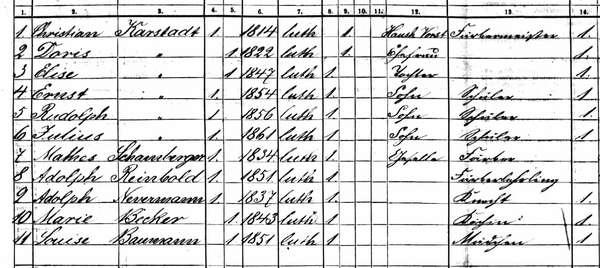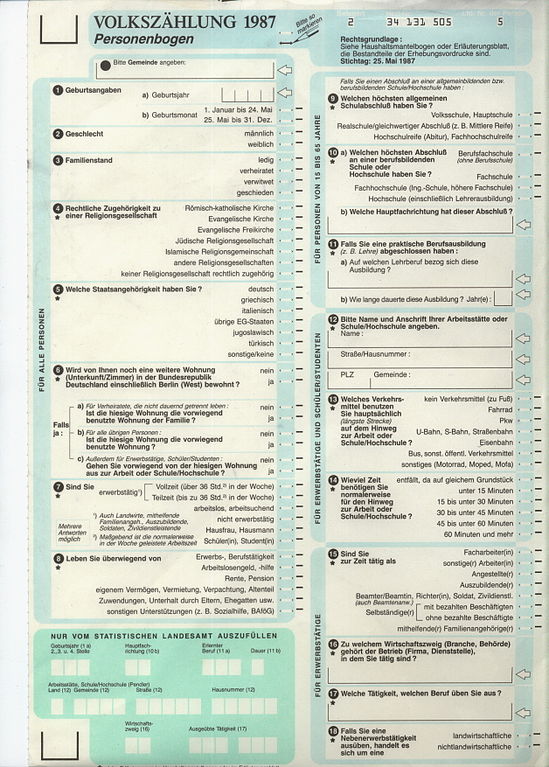A short story of German census
- 13. September 2019 - General, Germany, Historical Documents, Knowledge
The first census of the Federal Republic of Germany (FRG) was conducted on 13 September 1950. However, this was not the first census on German territory. As early as during the 18th century, kingdoms and principalities occasionally took censuses of their population. From 1816 onwards, censuses became a periodical habit throughout today’s German territory. Until now, this data is an interesting source for genealogists, although civil and church registers are better accessible and preserved.
In the beginning, the separate German States conducted population censuses independently from one another. Results usually were rough estimates grounded on church and resident registration registers. Names were rarely or never cited so that censuses only served statistical purposes.
Economic purposes
This changed in 1828 with the establishment of the first customs union on German territory between Bavaria and Wurttemberg, and with the customs union under Prussian leadership. Attempts were made to distribute revenues of tolls evenly among the states and eventually the citizens. Therefore, the census data collected was extended. This means that the first censuses that were standardized to some extend were economically motivated.
Even though almost all German States had conducted censuses since 1830, there were no coherent procedures, resulting in a large variety of the quantity of information and the reliability of the data.
The foundation of the German Customs Union in 1834 which comprised many of the German antecedent states led to a change in the procedures of census. The founding contract of the German Customs Union determined to conduct censuses every three years in a consistent manner so that the distribution of toll revenues would in result be fair and appropriate. As well, specific days in the beginning of December were appointed to the conduction of the censuses, towns with over 300,000 inhabitants were granted three days to complete them. The reason for this is quite trivial: it was assumed that the vast majority of inhabitants would be at home during December. Above all, census continued to be mostly statistical by nature.

Names, dates, facts
A slow change can be noticed from 1840 onwards with the implementation of census lists on which a number of names were cited for the first time. The ones named were mostly house owners and head of families. The rest of the persons were usually just counted or noted according to their sex.
Finally, in the year 1843 the German Customs Union imposed that every person had to be listed individually and forbid the usage of church or resident registration records for census calculation purposes. Comprehensive census lists were introduced in 1858 and from 1864 onwards, every individual had to be registered on the specially created census forms in order to prevent duplicate listings.
The German Empire (1871-1918) conducted the first census in all over Germany. A standardization of censuses was however still not completed wholly. Between 1875 and 1910 every five years a census was taken, after that in irregular intervals. The censuses from 1916 and 1917 do not count as regular population censuses. They were used to evenly distribute food rations. From 1919 on, census regained regularity.
From 1871 to 1919 the “locally present population” was counted, and for the 1925 and 1933 censuses the residential population was recorded. The latter means that inhabitants were recorded according to their main place of residence.
The NS-Regime planned to take a census in 1937 but due to various territorial enlargements postponed it to 1939. This census contained a vast number of racist criteria taken among other reasons in preparation of the deportation and extinction of the Jewish population.
After the Second World War censuses were conducted in all of the four occupation zones documenting the dead of the war and the migration and refugee flows coming from the former German eastern territories.
Censuses in the German Democratic Republic (GDR) were conducted in irregular intervals. From 1964 on, electronic data processing was used in the GDR as well as in the FRG.
In the FRG the population was recorded every five to nine years until 1970, and in the 1956 census on buildings and habitation the residing population was also registered. This arrangement is called a “kleine Volkszählung” (small census). Spectacular was the 1897 census which was accompanied by massive protests and boycotts focusing on data protection.
2001 saw preparations of a register-based census resting upon the German resident registration records. During the preparation process the fact that in the registration record 1.3 Million people were over counted attracted attention. Due to this, the census was not conducted.
In 2006 finally, the date of the next census was appointed to 09 May 2011. As before, this census was planned to be register-based. This had been made possible by the adjustment of the resident registration record in 2007 by the assignment of new tax IDs. The 2011 census was the first one conducted since the German reunification and therefore the first census being taken in all-German territory since 1946.
Since 2011, censuses are “synchronized” in all EU member states who are obliged to collect census data every ten years in May. The next register-based census will take place in 2021.
Door-to-door enquiries, register-based, or by use of questionnaire?
As you have read, the procedures used for taking censuses have changed over time. Data collection were first grounded in church and resident records, later “Volkszähler” (census taker) walked from door to door registering the present or residing persons (who were illiterate in some cases). Later on, questionnaires might have to be filled in by heads of households or individuals. By now, German censuses are register-based (on ground of the resident registration records), so that they are being taken quietly. Sampled household surveys are only conducted in addition to verify and enhance the data.
All these procedures are followed by different problems and error sources that can result in defective, missing or duplicate information.
So even though census data can be flawed and oftentimes only the statistical data has been archived while many of the questionnaires and census forms have been destroyed, census lists are still a relevant source for genealogists. Researching them can complete church and civil records and possibly fill in gaps. Unfortunately, preserved lists are oftentimes undeveloped or hardly accessible. Most census date has not been digitized and subscripted making a research time consuming and difficult.


27. September 2019
Dear Pat,
Thank you very much for your interest in our Blog.
There were censuses in Silesia, however since it belongs to Poland following WWII, it is even more complicated than for places within the borders of today's Germany. The documents would usually have to be found in Poland. Most of the time however, no census records are preserved. Still, it would be necessary to find out for the exact place you are looking for, in order to be sure.
We hope this answer helps you a little.
Your Beyond History team
15. September 2019
Since Silesia was still under Prussia in the early to mid 1800's would there be census data available in that area?